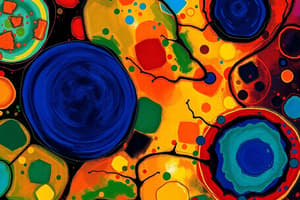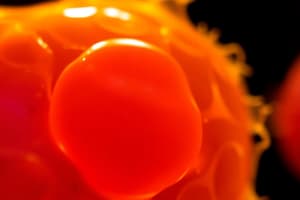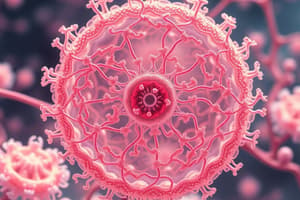Podcast
Questions and Answers
What characteristic of embryonic stem (ES) cells allows them to differentiate into various cell types?
What characteristic of embryonic stem (ES) cells allows them to differentiate into various cell types?
- They can only proliferate in specific environments.
- They maintain their pluripotent state. (correct)
- They can only differentiate into one cell type.
- They are derived from adult tissues.
ES cells can be used for disease modeling and organoid research.
ES cells can be used for disease modeling and organoid research.
True (A)
What ethical concern is associated with the use of embryonic stem cells?
What ethical concern is associated with the use of embryonic stem cells?
Sacrifice of human blastocysts.
The process of creating ES cells from patients using therapeutic cloning is known as _____ .
The process of creating ES cells from patients using therapeutic cloning is known as _____ .
Match the limitation with its description:
Match the limitation with its description:
What does LSD1 inhibition promote in hematopoietic stem cells (HSCs)?
What does LSD1 inhibition promote in hematopoietic stem cells (HSCs)?
Teratomas are a potential risk when transplanting stem cells.
Teratomas are a potential risk when transplanting stem cells.
What is one method to ensure the safety of transplanted stem cell material?
What is one method to ensure the safety of transplanted stem cell material?
The process of _____ refers to the transformation from endothelial cells to hematopoietic cells.
The process of _____ refers to the transformation from endothelial cells to hematopoietic cells.
Match the following terms with their correct descriptions:
Match the following terms with their correct descriptions:
What is a key characteristic of protocols designed to obtain specific cells from stem cells?
What is a key characteristic of protocols designed to obtain specific cells from stem cells?
It is not necessary to test the functionality of obtained cells from stem cells.
It is not necessary to test the functionality of obtained cells from stem cells.
Identify one challenge in the translation of stem cell therapies to clinical settings.
Identify one challenge in the translation of stem cell therapies to clinical settings.
What is one defining quality of stem cells?
What is one defining quality of stem cells?
Pluripotent stem cells can give rise to all three germ layers.
Pluripotent stem cells can give rise to all three germ layers.
In what year were the first human embryonic stem cell lines derived?
In what year were the first human embryonic stem cell lines derived?
Totipotent stem cells can give rise to a ______.
Totipotent stem cells can give rise to a ______.
Match the type of stem cells with their definitions:
Match the type of stem cells with their definitions:
What is a common source of embryonic stem cells?
What is a common source of embryonic stem cells?
Multipotent stem cells are capable of giving rise to any type of cell in the body.
Multipotent stem cells are capable of giving rise to any type of cell in the body.
What are the two main qualities of stem cells?
What are the two main qualities of stem cells?
What is a major risk associated with iPSC-derived cells?
What is a major risk associated with iPSC-derived cells?
Tumorigenicity in iPSC-derived cells is primarily due to complete silencing of oncogenic transcription factors.
Tumorigenicity in iPSC-derived cells is primarily due to complete silencing of oncogenic transcription factors.
In what year did Dr. E. Donnall Thomas perform the first successful stem cell transplant?
In what year did Dr. E. Donnall Thomas perform the first successful stem cell transplant?
Hematopoietic stem cells (HSCs) are most widely transplanted cells in _____ therapies.
Hematopoietic stem cells (HSCs) are most widely transplanted cells in _____ therapies.
Match the type of stem cell to its characteristic:
Match the type of stem cell to its characteristic:
Which of the following is NOT a consideration for HSC transplantation?
Which of the following is NOT a consideration for HSC transplantation?
Allogeneic HSC transplantation involves patient donation from the same individual.
Allogeneic HSC transplantation involves patient donation from the same individual.
Name a type of stem cell that can differentiate into osteocytes, chondrocytes, and adipocytes.
Name a type of stem cell that can differentiate into osteocytes, chondrocytes, and adipocytes.
What are mesenchymal stem cells (MSCs) known for in clinical applications?
What are mesenchymal stem cells (MSCs) known for in clinical applications?
Allogeneic MSCs are known for their long-term existence in the clinic.
Allogeneic MSCs are known for their long-term existence in the clinic.
What are the two types of stem cells classified as pluripotent?
What are the two types of stem cells classified as pluripotent?
Cord blood contains mesenchymal and __________ stem cells.
Cord blood contains mesenchymal and __________ stem cells.
Match the following stem cell considerations with their descriptions:
Match the following stem cell considerations with their descriptions:
What is a disadvantage of using cord blood for stem cell therapy?
What is a disadvantage of using cord blood for stem cell therapy?
The immune suppression properties of MSCs are not utilized in current clinical trials.
The immune suppression properties of MSCs are not utilized in current clinical trials.
What considerations must be made when translating stem cell therapy to the clinic?
What considerations must be made when translating stem cell therapy to the clinic?
Which of the following is NOT included in the quality control checklist for iPSCs?
Which of the following is NOT included in the quality control checklist for iPSCs?
Transdifferentiation is a method for efficiently delivering stem cells.
Transdifferentiation is a method for efficiently delivering stem cells.
Which therapy was developed at Lund University for treating Parkinson's disease?
Which therapy was developed at Lund University for treating Parkinson's disease?
The first use of fetal cells for Parkinson's disease treatment was pioneered by _____ and _____.
The first use of fetal cells for Parkinson's disease treatment was pioneered by _____ and _____.
Match the delivery methods to their descriptions:
Match the delivery methods to their descriptions:
Flashcards
Pluripotent Stem Cells
Pluripotent Stem Cells
Cells with the potential to develop into any cell type in the body, including all three germ layers (mesoderm, endoderm, and ectoderm).
Totipotent Stem Cells
Totipotent Stem Cells
Cells derived from a fertilized egg, capable of developing into a complete organism, including all cell types and tissues.
Multipotent Stem Cells
Multipotent Stem Cells
Cells found in adult tissues that can self-renew and differentiate into specialized cells within their respective tissues.
Embryonic Stem Cells (ES Cells)
Embryonic Stem Cells (ES Cells)
Signup and view all the flashcards
Induced Pluripotent Stem Cells (iPS Cells)
Induced Pluripotent Stem Cells (iPS Cells)
Signup and view all the flashcards
Stem Cell Therapy
Stem Cell Therapy
Signup and view all the flashcards
Self-Renewal
Self-Renewal
Signup and view all the flashcards
Differentiation
Differentiation
Signup and view all the flashcards
Pluripotency of ES cells
Pluripotency of ES cells
Signup and view all the flashcards
ES cells in developmental research
ES cells in developmental research
Signup and view all the flashcards
ES cells in cell therapy
ES cells in cell therapy
Signup and view all the flashcards
Ethical issues with ES cells
Ethical issues with ES cells
Signup and view all the flashcards
Immune rejection of ES cells
Immune rejection of ES cells
Signup and view all the flashcards
Hematopoietic Stem Cells (HSCs)
Hematopoietic Stem Cells (HSCs)
Signup and view all the flashcards
Allogeneic HSC Transplantation
Allogeneic HSC Transplantation
Signup and view all the flashcards
Autologous HSC Transplantation
Autologous HSC Transplantation
Signup and view all the flashcards
Graft-versus-host Disease (GVHD)
Graft-versus-host Disease (GVHD)
Signup and view all the flashcards
Graft-versus-Leukemia (GvL) Effect
Graft-versus-Leukemia (GvL) Effect
Signup and view all the flashcards
Mesenchymal Stem Cells (MSCs)
Mesenchymal Stem Cells (MSCs)
Signup and view all the flashcards
Short Tandem Repeat Analysis
Short Tandem Repeat Analysis
Signup and view all the flashcards
Identity Analysis
Identity Analysis
Signup and view all the flashcards
Residual Vector Testing
Residual Vector Testing
Signup and view all the flashcards
Karyotype Analysis
Karyotype Analysis
Signup and view all the flashcards
Phenotypic Pluripotency Assays
Phenotypic Pluripotency Assays
Signup and view all the flashcards
Cord Blood Stem Cells
Cord Blood Stem Cells
Signup and view all the flashcards
Ex Vivo Expansion of Hematopoietic Stem Cells
Ex Vivo Expansion of Hematopoietic Stem Cells
Signup and view all the flashcards
Challenges of Stem Cell Therapy Translation
Challenges of Stem Cell Therapy Translation
Signup and view all the flashcards
Safety Assessment of Stem Cell Transplantation
Safety Assessment of Stem Cell Transplantation
Signup and view all the flashcards
Efficient delivery of stem cells
Efficient delivery of stem cells
Signup and view all the flashcards
Stem Cell Differentiation
Stem Cell Differentiation
Signup and view all the flashcards
Ex Vivo HSC Expansion
Ex Vivo HSC Expansion
Signup and view all the flashcards
Quantitative Polymerase Chain Reaction (qPCR)
Quantitative Polymerase Chain Reaction (qPCR)
Signup and view all the flashcards
Lysine-Specific Demethylase 1 (LSD1)
Lysine-Specific Demethylase 1 (LSD1)
Signup and view all the flashcards
Hematopoietic Stem Cell Transplantation
Hematopoietic Stem Cell Transplantation
Signup and view all the flashcards
Aorta-Gonad-Mesonephros (AGM)
Aorta-Gonad-Mesonephros (AGM)
Signup and view all the flashcards
Study Notes
Overview of Stem Cell Therapies
- The presentation focuses on stem cell therapies, their current applications, and associated challenges
- Learning outcomes include defining stem cells, classifying stem cell types, describing therapeutic applications, and discussing current limitations
- The lecture will cover parts on what stem cells are, stem cell classification, translation to the clinic, and current applications of stem cell therapies
Stem Cell Therapies: Regenerative Medicine
- Why use stem cells? A major shortage in donated organs and the incompatibility of available organs necessitates the search for alternatives like stem cell therapies. 103,223 people are on the national transplant waiting list in the U.S.
- How do stem cells work? Stem cell therapies aim to repair/replace tissues or organs, rather than merely treating symptoms. This involves replacing damaged or defective cells with new, healthy ones.
- Stem cell sources: Isolated or induced stem cells are vital for this application
What are Stem Cells?
- Stem cells exhibit two defining qualities: self-renewal (ability to create more stem cells of the same type) and differentiation (the ability to develop into special cell types)
- There exist varying types of stem cells, including hematopoietic stem cells, mesenchymal stem cells among others
Stem Cell Classification
- Totipotent: Stem cells capable of giving rise to an entire organism (e.g., a zygote)
- Pluripotent: Stem cells generating all three germ layers (mesoderm, endoderm, and ectoderm) (e.g., embryonic stem cells, induced pluripotent stem cells)
- Multipotent: Generating multiple cell types within a specific lineage or tissue (e.g., adult stem cells)
Embryonic Stem Cells (ES Cells)
- Murine ES cell lines were first established in 1981
- Human ES cell lines were first derived in 1998
- ES cells are derived from excess IVF eggs donated for research
ES Cells and their Potential
- ES cells proliferate indefinitely, maintaining their pluripotent state
- They can differentiate into various cell types including neurons, blood cells, cardiomyocytes, and liver cells
- Essential for in vitro studies of developmental processes otherwise not assessable
- Crucial in disease modeling research (genetic diseases, human-host pathogen interactions, organoid research)
- Hold great potential in advancing cell therapy (transplantation to patients of cells differentiated from ES cells)
Limitations of ES Cells
- Ethical concerns arise around using human blastocysts (which are destroyed to obtain ES cells). Strict regulations may be in place in various regions.
- Allogeneic transplantation of ES cells (from a different organism) can trigger immune rejection if the human leukocyte antigen (HLA) haplotypes do not match.
- Biobanking (creating a bank of ES cells with common HLA haplotypes) offers a solution to the immune rejection problem. A significant number of HLA-typed cell lines (150) are required to cover a large section of the population.
- Somatic cell nuclear transfer (SCNT) can be used to create cells with a matching patient HLA. The technique involves the reprogramming of adult cells.
Somatic Cell Nuclear Transfer (SCNT)
- John B. Gurdon's pioneering work in this field earned him the Nobel Prize for the discovery in 2012 of reprogramming mature cells into pluripotent ones
- The process of SCNT includes steps where a nucleus is transferred from a donor cell to an enucleated egg cell to generate a new embryo. Dolly the sheep (1996) is a significant example
Therapeutic Cloning
- An application of SCNT
- Using the body's own cells to create needed cells
Induced Pluripotent Stem Cells (iPSCs)
- In 2006, Shinya Yamanaka's lab showed that fully differentiated somatic cells can be reprogrammed into a pluripotent stem cell state. This is a crucial discovery in stem cell research.
- iPSCs offer advantages analogous to ES cells but without the ethical concerns or the need for donor eggs.
- iPS cells are easily accessible and vastly renewable (no limit to obtaining more iPSCs). Cell numbers are not a limitation; they can be made and stored.
- iPSCs can be generated from a variety of somatic cells (blood, keratinocytes, fibroblasts, hepatocytes). This allows iPSCs to be personalized to the patient (or non-immunogenic).
Limitations of iPSCs
- Risk of incomplete differentiation of some iPSC-derived cells
- Potential for genomic and epigenetic alterations in iPSC-derived cells.
- Risk of tumorigenicity due to insufficient silencing of oncogenic transcription factors like Myc and Klf4
- Personalized medicine may present challenges in terms of practical application, with some needing 10 months or more of the wait and nearly US$1 million in costs for retinal pigment epithelium (RPE) iPSC-derived cell operations.
Multipotent Stem Cells
- Multipotent stem cells generate multiple types of cells within a specific lineage or tissue (e.g., adult stem cells)
- Sources (e.g., brain, spinal cord, liver, blood vessels, pancreas, skin epithelia) are often hard to isolate
Hematopoietic Stem Cells (HSCs)
- Most widely transplanted stem cells in stem cell therapies
- Transplanting HSCs to the bone marrow replenishes the patient's hematopoietic system.
- HSCs have been widely used in treating diseases like leukemia.
History of HSC Transplantation
- The aftermath of World War II led to methods for reversing the death effect from radiation, which involved transplanting bone marrow.
- In 1956, Dr. E. Donnall Thomas performed the first successful HSC transplant, curing leukemia in an identical twin recipient.
Considerations for HSC Transplantation
- Graft-versus-host disease (GVHD)
- Conditioning regimens (1980s and 1990s)
Autologous vs. Allogeneic HSC Transplantation
- Autologous uses the patient's own cells.
- Allogeneic involves using cells from a donor, which can lead to graft-versus-host disease.
Indications for HSC Transplantation
- Several diseases, including malignancies (multiple myeloma, leukemia) and non-malignant disorders (autoimmune diseases), are treatable with HSC transplantation.
Mesenchymal Stem Cells (MSCs)
- MSCs differentiate into osteocytes, chondrocytes, and adipocytes.
- A variety of markers on the surfaces of MSCs have been identified but remain debated.
- Numerous clinical trials have investigated MSC use (nearly 1,000).
Mesenchymal Stem Cells (MSCs) - Clinical Use
- MSCs exhibit anti-inflammatory properties that can be used for tissue repair.
- They show short-term existence and thus can be allogeneically used in the clinic.
- Current MSC clinical trials focus on their immunomodulatory properties. Differences in their description and manufacturing processes exist.
Lecture Overview (Part 2)
- Translation to the clinic
- Current applications of stem cell therapies
Translation to the Clinic
- Consideration of translating stem cell therapies from research settings to real clinical applications.
- Overcoming the scarcity of stem cells
- Protocols for obtaining cells of interest
- Assessing safety of materials to be transplanted
- Efficient delivery methods
How to Overcome the Scarcity of Stem Cells
- Using alternate sources like cord blood, which contains HSCs. Cord blood can reduce HLA matching demands, lower GVHD risk, and increase donor availability.
- Expansion methods (i.e., expanding hematopoietic stem cells ex vivo: utilizing extracellular matrices, co-cultures, culture conditions, and small molecules like UM171, to enhance the growth of HSCs).
How to Design Protocols to Obtain Cells Relevant for Transplants from Stem Cells
- Implementing Good Manufacturing Practices (GMP) compliant protocols for optimal differentiation of cells from pluripotent stem cells
- Ensuring cells of interests are obtained (e.g., assessing markers)
- Conducting functionality testing for the cells
How to Ensure the Safety of Transplanted Material
- Identifying genomic integrity (checking for genomic insults, CNVs, SNP reprogramming errors and genetic mosaicism)
- Implementing a quality control list for iPSCs (e.g., short tandem repeat analysis, residual vector testing, karyotype, bacterial and viral testing, flow cytometry, phenotypic assays, and histone modification/DNA methylation)
How to Efficiently Deliver the Cells
- Creating and using bioengineered delivery systems such as biomaterials (cell sheets, injectable hydrogels, porous scaffolds nanoscaffolds, surface engineered materials, microencapsulation, and microengineered hydrogels) and using organoids.
- Exploring delivery strategies using transdifferentiation (reprogramming or differentiating cells into the desired cell type).
Disease Examples
- Parkinson's disease, utilizing either fetal tissue grafts or iPSCs. Lund University pioneered this area of research. Regulatory approval for a phase I Ila clinical trial of a new stem cell therapy for Parkinson's (STEM-PD) was secured
- IPSC-derived cell therapies are being trialled for various diseases (nervous system disorders, respiratory system disorders, immune system disorders).
Summary of Stem Cell Clinics
- There are numerous stem cell research labs throughout the world.
- The U.S. has businesses selling unproven or unlicensed stem cell interventions. This highlights the critical need for proper quality control checks.
Studying That Suits You
Use AI to generate personalized quizzes and flashcards to suit your learning preferences.




